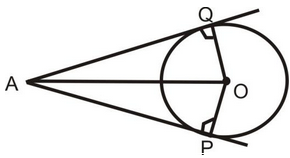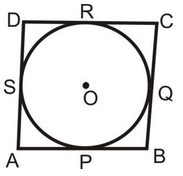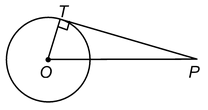
Theorem 2
Circles of Class 10
Lengths of two tangents drawn from an external point to a circle are equal.

Given: AP and AQ are two tangents drawn from a point A to a circle C (O, r).
To prove: AP = AQ.
Construction: Join OP, OQ and OA.
Proof: In ΔAOQ and ΔAPO
∠OQP = ∠OPA [Tangent at any point of a circle is perp. to radius through the point of contact]
AO = AO [Common]
OQ = OP [Radius]
So by R.H.S. criterion of congruency Δ AOQ ≅ ΔAOP .
∴ AQ = AP. [By CPCT] Hence Proved
RESULT:
-
If two tangents are drawn to a circle from an external point, then they subtend equal angles at the centre. ∠OAQ = ∠OAP [By CPCT].
-
If two tanagents are drawn to a circle from an external point, they are equally inclined to the segment, joining the centre to that point ∠OAQ = ∠OAP [By CPCT].
question 1. If all the sides of a parallelogram touches a circle, show that the parallelogram is a rhombus.
Solution: Given: Sides AB, BC, CD and DA of a ||gm ABCD touch a circle at P,Q,R and S respectively.
To prove ||gm ABCD is a rhombus.

Proof : AP = AS .......(i)
BP = BQ .......(ii)
CR = CQ .......(iii)
DR = DS ........(iv)
[Tangents drawn from an external point to a circle are equal]
Adding (1), (2), (3) and (4), we get
⇒ AP + BP + CR + DR = AS + BQ + CQ + DS
⇒(AP + BP) + (CR + DR) = (AS + DS_ + (BQ + CQ)
⇒ AB + CD = AD + BC
⇒ AB + AB = AD + AD [In a ||gm ABCD, opposite side are equal]
⇒ 2AB = 2AD or AB = AD.
But AB = CD AND AD = BC [Opposite sides of a || gem]
∴ AB = BC = CD = DA.
Hence, ||gm ABCD is a rhombus.
question 2. From a point P, 10 cm away from the centre of a circle, a tangent PT of length 8 cm is drawn. Find the radius of the circle.
Solution: Let O be the centre of the given circle and let P be a point such that OP = 10 cm.
Let PT be the tangent such that PT = 8 cm.
Join OT.
Now PT is a tangent at T and OT is the radius through T.

∴ OT ⊥ PT [Radius is ⊥ to tangent at the point of contact]
In the right ΔOTP, we have
OP 2 = OT 2 + PT 2 [by Pythagoras' theorem]
⇒

Hence, the radius of the circle is 6 cm.









